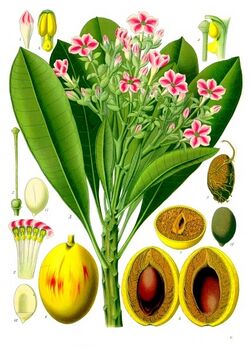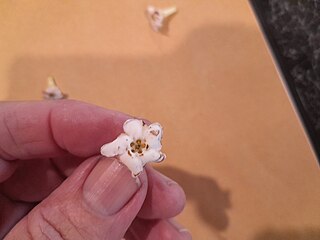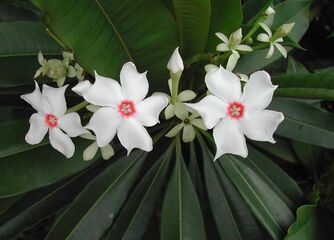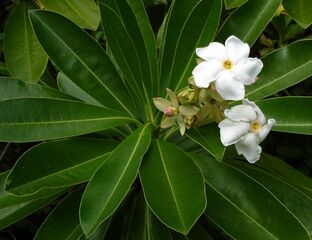Biology:Cerbera
| Cerbera | |
|---|---|

| |
| Cerbera manghas | |
| Scientific classification | |
| Kingdom: | Plantae |
| Clade: | Tracheophytes |
| Clade: | Angiosperms |
| Clade: | Eudicots |
| Clade: | Asterids |
| Order: | Gentianales |
| Family: | Apocynaceae |
| Subfamily: | Rauvolfioideae |
| Tribe: | Plumerieae |
| Subtribe: | Thevetiinae |
| Genus: | Cerbera L., 1753[1] |
| Type species | |
| Cerbera manghas L., 1753
| |
| Synonyms[1] | |
Cerbera is a genus of evergreen trees or shrubs, native to tropical Asia, Australia , Madagascar , and various islands in the Indian and Pacific Oceans.[2][3]
Three trees of this genus are mangroves, Cerbera floribunda, Cerbera manghas and Cerbera odollam.
Description
They are perennial trees or shrubs growing up 30 m (98 ft) high, the branches with conspicuous leaf scars. The leaves are spirally arranged and crowded towards the ends of the branches. Each has up to 30 lateral veins that may be straight or upcurved, at 50 to 90 degrees to the midrib. All parts produce a white sticky latex.[2][3][4]:570[5]:7
The inflorescences are terminal with long peduncles, flowers are carried on short pedicels. Sepals are mostly free and usually pale green, the corolla is white, with a red, pink, yellow or white centre. Flowers are 5–merous and actinomorphic, i.e. they are symmetric and can be divided in equal halves along any diameter.[2][3][4]:570[5]:7
The fruit are ellipsoid drupes containing one or two seeds, and may be green, red, purple or blue.[2][3][4]:570[5]:8
Taxonomy
Cerbera was first described by Carl Linnaeus in 1753 in his work Species Plantarum, in which he described three species — C. manghas, C. thevetia and C. ahouai. Of these, only C. manghas is still included in Cerbera (the other two having been moved to other genera) and is considered to be the lectotype.[4]:569
The genus is most closely related to Cerberiopsis Vieil., Thevetia L. and Cascabela Raf..[4]:569
Etymology
The genus is named after Cerberus, a three-headed dog in Greek mythology, because all the species are poisonous — they contain cerberin, a cardiac glycoside, a substance that blocks electric impulses in the body (including the beating of the heart). Therefore, it is advised to avoid using wood from Cerbera species due to their toxicity, and as their smoke may cause lethal poisoning.
Species
The following is a list of all six species in this genus that are accepted by Plants of the World Online (As of September 2023) [1]
- Cerbera dumicola P.I.Forst. - Queensland
- Cerbera floribunda K.Schum. - Sulawesi, Maluku, Caroline Islands, New Guinea, Bismarck Archipelago, Solomon Islands, Queensland.
- Cerbera inflata S.T. Blake - New Guinea, Bismarck Archipelago, Queensland.
- Cerbera laeta Leeuwenb. - New Guinea
- Cerbera manghas L. - Tanzania, Madagascar, the Indian subcontinent, mainland Southeast Asia, Malesia, Papuasia, northern Australia and numerous Pacific islands
- Cerbera odollam Gaertn. - Indian subcontinent, mainland Southeast Asia, Malesia, Papuasia and numerous Pacific islands
Formerly included here
- Cerbera obovata Roem. & Schult., now Craspidospermum verticillatum Bojer ex Decne.[6]
- Cerbera oppositifolia Lam., now Ochrosia oppositifolia (Lam.) K.Schum.[7]
- Cerbera thevetia L., now Cascabela thevetia (L.) Lippold[8]
- Cerbera ahouai L., now Thevetia ahouai (L.) Vahl[9]
Gallery
References
- ↑ 1.0 1.1 1.2 "Cerbera L.". Royal Botanic Gardens, Kew. https://powo.science.kew.org/taxon/urn:lsid:ipni.org:names:60436653-2.
- ↑ 2.0 2.1 2.2 2.3 Forster, P.I. (2022). "Cerbera". Australian Biological Resources Study, Department of Climate Change, the Environment and Water: Canberra. https://profiles.ala.org.au/opus/foa/profile/Cerbera.
- ↑ 3.0 3.1 3.2 3.3 "Cerbera". Missouri Botanical Garden, St. Louis, MO & Harvard University Herbaria, Cambridge, MA.. http://www.efloras.org/florataxon.aspx?flora_id=2&taxon_id=106213.
- ↑ 4.0 4.1 4.2 4.3 4.4 Forster, P. I. (1992). "A taxonomic revision of Cerbera L. (Apocynaceae) in Australia and Papuasia". Austrobaileya 3 (4): 570.
- ↑ 5.0 5.1 5.2 Leeuwenberg, A. J. M. (1999). "Series of revisions of Apocynaceae XLVII. The genus Cerbera L.". Agricultural University Wageningen Papers 98 (3). https://edepot.wur.nl/282967.
- ↑ "Cerbera obovata Roem. & Schult.". Royal Botanic Gardens, Kew. https://powo.science.kew.org/taxon/urn:lsid:ipni.org:names:77911-1.
- ↑ "Cerbera oppositifolia Lam.". Royal Botanic Gardens, Kew. https://powo.science.kew.org/taxon/urn:lsid:ipni.org:names:77914-1.
- ↑ "Cerbera thevetia L.". Royal Botanic Gardens, Kew. https://powo.science.kew.org/taxon/urn:lsid:ipni.org:names:52627-2.
- ↑ "Cerbera ahouai L.". Royal Botanic Gardens, Kew. https://powo.science.kew.org/taxon/urn:lsid:ipni.org:names:77883-1.
Wikidata ☰ Q1743845 entry
 |





